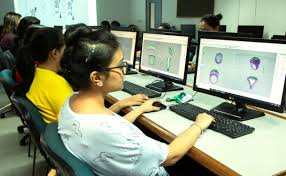Diamond Asserter
SECTOR: GEMS & JEWELLERY
SUB-SECTOR: Cast and Diamonds-Set Jewellery
OCCUPATION: Procuring and assorting
REFERENCE ID: G&J/Q2502
ALIGNED TO: NCO-2004/7313.35
Diamond Assorter: A Diamond Assorter is also known as ‘Assorter’ in cast and
diamond-set jewellery manufacturing in India. An assorter, sorts diamonds
according to its cut, carat, colour and clarity.
Brief Job Description: Individuals working as assorter have to separate
polished diamonds and group them into lots having similar characteristics and
reject which are not as per required quality. It is done by looking at the
diamond through an eye glass under light and requires experience in spotting
similar type of diamonds. Each diamond is assessed according to its
characteristics of cut, carat, colour and clarity.
Personal Attributes: The job requires the individual to have in-depth
knowledge of diamonds, good eyesight and vast experience in order to judge
the quality of each diamond. It also requires high level of concentration and
patience. The individual is expected to have integrity in dealing with diamonds
Assort diamond into different categories
Unit Code G&J/N2502
Unit Title
(Task) Assort diamond in different categories
Description This OS unit is about segregation of diamonds of similar characteristics into groups
having similar characteristics of required quality and reject which are not as per
required quality; selected diamonds are further distributed for cast and diamond-set
jewellery manufacturing
Scope This unit/task covers the following:
Receive the packet of diamonds from diamond procurer
follow instructions of diamond procurer in terms of sorting
check the weight and number of stones, w.r.t what is mentioned on the packet
use a sieve to classify the diamonds based on its size
do a basic sorting based on shape and size
Look at each diamond individually through an eye glass and make further classification
into groups as per company policy, e.g.:
select diamonds which are of similar characteristics such as cut, carat, colour and
clarity and segregate as per quality required by the company
reject diamonds which are not as per required quality
buffer stock, diamonds which are of required quality but do not match with the
selected lots, are kept aside as a buffer stock to meet the future requirement or
resold to diamond traders
Report problems about:
mismatch in the number of diamonds
difference in the actual quality of diamonds vis-à-vis specified on packet any problems in identification of diamonds
difficulty in classifying a particular diamond in terms of unclear characteristics
Performance Criteria (PC) w.r.t. the Scope
Element Performance Criteria
Assorting quality To be competent, the user/individual on the job must be able to:
PC1. accurately segregate/group the diamonds as per the company’s policy
PC2. identify different characteristics of diamonds, example –
i. Cut – round, princess, emerald, etc.
ii. Carat – one metric carat = 1/5 gram, or 200 milligrams
iii. Colour – colourless (D, E, F), near colourless (G, H, I, J), etc. and
iv. Clarity – flawless (F), Very, Very Small Inclusions (VVS1, VVS2), etc.
PC3. use judgment for selecting and rejecting diamond
PC4. ensure near zero damage/loss to the diamond
To be competent, the user/individual on the job must be able to:
PC5. improve speed of sorting / time taken per stone
PC6. achieve number of diamonds sorted as per the target assigned
Process compliances To be competent, the user/individual on the job must be able to:
PC7. comply with relevant legislation, standards, policies and procedures
Knowledge and Understanding (K)
A. Organizational
Context
The user/individual on the job needs to know and understand:
KA1. company’s policies on: quality, incentives, delivery standards, safety and
hazards, integrity and personnel management
KA2. work flow involved in cast and diamond-set jewellery manufacturing
KA3. importance of the individual’s role in the workflow
KA4. reporting structure
KA5. typical customer profile and market trends
KA6. specialization of the company (size, clarity, shape, quality, etc., of diamonds)
B. Technical
Knowledge
The user/individual on the job needs to know and understand:
KB1. identification of diamonds
KB2. process of diamond procurement such as from the processing units, traders
KB3. 4 C’s of diamond (colour, cut, clarity and carat)
KB4. diamond shading – colour wise
KB5. application of diamonds as per the jewellery types
KB6. gauging and sieving
KB7. valuing diamond on market practice
Skills (S) [Optional]
A. Core Skills/
Generic Skills
Reading and writing skills
The user/ individual on the job needs to know and understand how to:
SA1. read notes, designs and instructions in terms of diamond requirement
SA2. read company rules and compliance documents required to complete the work
SA3. maintain records of diamonds
Calculation and Geometry skills
The user/individual on the job needs to know and understand how to:
SA4. count the number of diamonds and/or gemstones and weight of diamonds
SA5. assess accuracy of dimensions and symmetry
SA6. mathematical calculations used in sorting
SA7. estimate the value of diamonds
Teamwork
The user/individual on the job needs to know and understand how to:
SA8. share work load as required
SA9. assist others who require help
SA10. take feedback from co-workers and supervisor and share knowledge with them
B. Professional Skills Decision Making
The user/individual on the job needs to know and understand:
SB1. quality of diamonds as per the requirement of the company
SB2. how to judge the diamond quality to be able to select, reject or keep buffer
Plan and Organize
The user/individual on the job needs to know and understand how to:
SB3. plan and organize work in order to ensure accurate and timely assortment
SB4. manage and secure stocks
SB5. maintain records of the diamond stocks
Diamond Valuing
The user/individual on the job needs to know and understand how to:
SB6. derive the approximate value of the diamond based on its brilliance in cast and
diamond-set jewellery
Analytical Thinking
The user/individual on the job needs to know and understand how:
SB7. to use the knowledge/experience about similar quality of diamonds in the past
to predict the quality of the current lot
Critical thinking
The user/individual on the job needs to know and understand how to:
SB8. apply, analyze, and evaluate the knowledge gathered from observation,
experience, reasoning, or communication, as a guide to thought and action
SB9. spot process disruptions and delays
Coordinate with others
Unit Code G&J/N9902
Unit Title
(Task) Interact with colleagues and seniors
Description This OS unit is about communicating with colleagues and seniors in order to achieve
smooth and hazard-free work flow
Scope This unit/task covers the following:
Interact with supervisor
receive work instructions and raw materials from reporting supervisor
communicate to reporting supervisor about process-flow improvements, product
defects received from previous process, repairs and maintenance of tools and
machinery as required
communicate any potential hazards or expected process disruptions
handover completed work to supervisor
Interact with colleagues within and outside the department
work as a team with colleagues and share work as per their or own work load and
skills
work with colleagues of other departments
communicate and discuss work flow related difficulties in order to find solutions
with mutual agreement
receive feedback from qc and rework in order to complete work on time
Performance Criteria(PC) w.r.t. the Scope
Element Performance Criteria
Interaction with
supervisor
To be competent, the user/individual on the job must be able to:
PC1. understand the work output requirements
PC2. comply with company policy and rule
PC3. deliver quality work on time as required by reporting any anticipated reasons
for delays
Interactions with
colleagues and other
departments
To be competent, the user/individual on the job must be able to:
PC4. put team over individual goals
PC5. be able to resolve conflicts
PC6. learn how to multi-task relevant activities
Knowledge and Understanding (K)
A. Organizational
Context
The user/individual on the job needs to know and understand:
KA1. company’s policies on: preferred language of communication, reporting and
escalation policy, quality delivery standards, and personnel management
KA2. reporting structure
B. Technical
Knowledge
The user/individual on the job needs to know and understand how to:
KB1. communicate effectively
KB2. build team coordination
G&J/N9902 Coordinate with others
10
Skills (S) [Optional]
A. Core Skills/
Generic Skills
Communication skills
The individual on the job needs to know and understand how to:
SA1. read and write preferred language of communication as prescribed by the
company
SA2. read job sheets and interpret technical details mentioned in the job sheet
B. Professional Skills Decision making
The individual on the job needs to know and understand:
SB1. how to spot and communicate potential areas of disruptions to work process
and report the same
SB2. when to report to supervisor and when to deal with a colleague individually,
depending on the type of concern
Reflective thinking
The individual on the job needs to know and understand how to:
SB3. improve work processes by interacting with others and adopting best
practices
Critical thinking
The individual on the job needs know and understand how to:
SB4. spot process disruptions and delays and report and communicate with
solutions
Unit Code G&J/N9905
Unit Title
(Task) Maintain occupational health and safety
Description This OS unit is about being aware of, communicating and taking steps towards
minimizing potential hazards and dangers of accidents on the job and maintaining
occupational health and safety
Scope This unit/task covers the following:
Understand potential sources of accidents
to avoid accidents related to use of potentially dangerous chemicals, sharp tools
and machines
Use safety gear to avoid accidents
wear safety gear such as goggles, mask, gloves, ear plugs
Actively participate in the health and safety awareness campaigns
attend fire drills organised by the company or industrial zone
learn first aid procedure
be alert about designated assembly area in the event of an emergency
read and understand the evacuation and emergency procedures
Communicate to reporting supervisor about:
process flow improvements that can reduce anticipated or repetitive hazards
mishandling of tools, machines or hazardous materials
electrical problems that could result in accident
Performance Criteria(PC) w.r.t. the Scope
Element Performance Criteria
Communicating
potential accident
points
To be competent, the user/individual on the job must be able to:
PC1. spot and report potential hazards on time
PC2. follow company policy and rules regarding use of hazardous materials
PC3. attend and actively participate in the health and safety campaigns organised
by the company
Using safety gear To be competent, the user/individual on the job must be able to:
PC4. use or wear safety gear as per the rules of the company
Knowledge and Understanding (K)
A. Organizational
Context
The user/individual on the job needs to know and understand:
KA1. company’s policies on: safety and hazards and personnel management
KA2. reporting structure
B. Technical
Knowledge
The user/individual on the job needs to know and understand:
KB1. how different chemicals react and what could be the danger from them
KB2. how to use machines and tools without suffering bodily harm
G&J/N9905 Maintain occupational health and safety
14
Skills (S) [Optional]
A. Core Skills/
Generic Skills
Communication skills
The individual on the job needs to know and understand how to:
SA1. effectively communicate the danger
Organising skills
The individual on the job needs to know and understand how to:
SA2. keep all the tools in an organised manner so as to avoid accidents
SA3. keep the work environment safe and clean
B. Professional Skills Decision making
The individual on the job needs to know and understand how to:
SB1. report potential sources of danger
SB2. follow prescribed procedure in the event of an accident
SB3. wear appropriate safety gear to avoid an accident
Reflective thinking
The individual on the job needs to know and understand to:
SB4. learn from past mistakes regarding use of hazardous machines or chemicals
Critical thinking
The individual on the job needs to know and understand how to:
SB5. spot danger
Decision making
The individual on the job needs to know and understand how to:
SB6. report potential sources of danger
SB7. follow prescribed procedure in the event of an accident
SB8. wear appropriate safety gear to avoid an accident
Keywords /Terms Description
Sector Sector is a conglomeration of different business operations having similar
business and interests. It may also be defined as a distinct subset of the
economy whose components share similar characteristics and interests.
Sub-sector Sub-sector is derived from a further breakdown based on the
characteristics and interests of its components.
Occupation Occupation is a set of job roles, which perform similar/ related set of
functions in an industry.
Function Function is an activity necessary for achieving the key purpose of the
sector, occupation, or an area of work, which can be carried out by a
person or a group of persons. Functions are identified through functional
analysis and form the basis of OS.
Sub-function Sub-functions are sub-activities essential to fulfil the achieving the
objectives of the function.
Job role Job role defines a unique set of functions that together form a unique
employment opportunity in an organisation.
Occupational Standards
(OS)
OS specify the standards of performance an individual must achieve
when carrying out a function in the workplace, together with the
knowledge and understanding they need to meet that standard
consistently. Occupational Standards are applicable both in the Indian
and global contexts.
Performance Criteria Performance criteria are statements that together specify the standard of
performance required when carrying out a task.
National Occupational
Standards (OS)
NOS are occupational standards which apply uniquely in the Indian
context.
Qualifications Pack (QP) QP comprises the set of OS, together with the educational, training and
other criteria required to perform a job role. A QP is assigned a unique
qualifications pack code.
Unit Code Unit code is a unique identifier for an Occupational Standard, which is
denoted by an ‘N’
Unit Title Unit title gives a clear overall statement about what the incumbent
should be able to do.
Description Description gives a short summary of the unit content. This would be
helpful to anyone searching on a database to verify that this is the
appropriate OS they are looking for.
Scope Scope is a set of statements specifying the range of variables that an
individual may have to deal with in carrying out the function which have
a critical impact on quality of performance required.
Knowledge and
Understanding
Knowledge and understanding are statements which together specify the
technical, generic, professional and organisational specific knowledge
that an individual needs in order to perform to the required standard.
Organisational Context Organisational context includes the way the organisation is structured
and how it operates, including the extent of operative knowledge
managers have of their relevant areas of responsibility.
Technical Knowledge Technical knowledge is the specific knowledge needed to accomplish
specific designated responsibilities.
Core Skills/ Generic
Skills
Core skills or generic skills are a group of skills that are the key to learning
and working in today’s world. These skills are typically needed in any
work environment in today’s world. These skills are typically needed in
any work environment. In the context of the OS, these include
communication related skills that are applicable to most job roles.
Keywords /Terms Description
CAD Computer Aided Design
CAM Computer Aided Manufacturing
IPR Intellectual Property Rights
NOS National Occupational Standard(s)
NVQF National Vocational Qualifications Framework
NSQF National Qualifications Framework
NVEQF National Vocational Education Qualifications Framework
QP Qualifications Pack
CRITERIA FOR ASSESSMENT OF TRAINEES
Job Role Qualifications Pack- Diamond Assorter
Qualification Pack Qualifications Pack- Diamond Assorter
Sector Skill Council
GEMS & JEWELLERY
Assessment Strategy Marks Allocation
NOS Elements Performance Criteria Theory Practical
- G&J/N2502 Assort diamond into
different categories
Assorting quality
PC1. accurately segregate/group the diamonds as per the company’s policy 2 14
PC2. identify different characteristics of diamonds, example –
i. Cut – round, princess, emerald, etc.
ii. Carat – one metric carat = 1/5 gram, or 200 milligrams
iii. Colour – colourless (D, E, F), near colourless (G, H, I, J), etc. and
iv. Clarity – flawless (F), Very, Very Small Inclusions (VVS1, VVS2), etc.
2 14
PC3. use judgment for selecting and rejecting diamond 2 14
PC4. ensure near zero damage/loss to the diamond 1 7
Productivity PC5. improve speed of sorting / time taken per stone 1 7
PC6. achieve number of diamonds sorted as per the target assigned 1 7
Process compliances PC7. comply with relevant legislation, standards, policies and procedures 1 7
10 70 - G&J/N9902 Coordinate with others
Interaction with supervisor
PC1. understand the work output requirements 1 2
PC2. comply with company policy and rule 1 2
PC3. deliver quality work on time as required by reporting any anticipated reasons for delays 1 2
Interactions with colleagues and
other departments
PC4. put team over individual goals 1 0
PC5. be able to resolve conflicts 1 0
PC6. learn how to multi-task relevant activities 1 0
6 6 - G&J/N9905 Maintain occupational
health and safety
Communicating potential
accident points
PC1. spot and report potential hazards on time 1 0
PC2. follow company policy and rules regarding use of hazardous materials 1 2
PC3. attend and actively participate in the health and safety campaigns organised by the
company
1 0
Using safety gear PC4. use or wear safety gear as per the rules of the company 1 2








